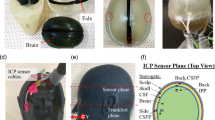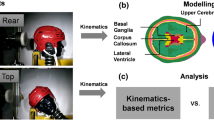Abstract
Chin-to-chest impact commonly occurs in frontal crash simulations with restrained anthropomorphic test devices (ATDs) in non-airbag situations. This study investigated the biofidelity of this contact by evaluating the impact response of both the chin and manubrium of adult post-mortem human subjects (PMHSs). The adult PMHS data were scaled to a 10-year-old (YO) human size and then compared with the Hybrid III 10YO child (HIII-10C) ATD response with the same test configurations. For both the chin and manubrium, the responses of the scaled PMHS had different characteristics than the HIII-10C ATD responses. Elevated energy impact tests to the PMHS mandible provided a mean injury tolerance value for chin impact force. Chin contact forces in the HIII-10C ATD were calculated in previously conducted HYGE sled crash simulation tests, and these contact forces were strongly correlated with the Head Injury Criterion (HIC36 ms). The mean injurious force from the PMHS tests corresponded to a HIC36 ms value that would predict an elevated injury risk if it is assumed that fractures of the chin and skull are similarly correlated with HIC36 ms. Given the rarity of same occupant-induced chin injury in booster-seated occupants in real crash data and the disparity in chin and manubrium stiffnesses between scaled PMHS and HIII-10C ATD, the data from this study can be made use of to improve biofidelity of chin-to-manubrium contact in ATDs.











Similar content being viewed by others
Notes
The PMHS were available through the body donor program at The Ohio State University’s Injury Biomechanics Research Laboratory, and applicable NHTSA guidelines as well as IRB protocol were followed.
References
Ash, J., et al. Comparison of anthropomorphic test dummies with a pediatric cadaver restrained by a three-point belt in frontal sled tests. In: Enhanced Safety of Vehicles. Paper No. 09-0362, 2009.
Craig, M., C. Bir, D. Viano, and S. Tashman. Biomechanical response of the human mandible to impacts of the chin. J. Biomech. 41:2972–2980, 2008.
Craig, M., D. Viano, and C. Bir. Jaw Loading Response of Current ATDs. SAE 2009-01-0388, pp. 587–599, 2009.
HIII-10C Drawing Package. http://www.regulations.gov/#!documentDetail;D=NHTSA-2005-21247-0004.
Hopper, R. H., J. H. McElhaney, and B. S. Myers. Mandibular and basilar skull fracture tolerance. In: Proc. 38th Stapp Car Crash Conference. Warrendale, PA: Society of Automotive Engineers, 1994.
Kallieris, D., et al. Comparison between child cadavers and child dummy using child restraint systems in simulated collisions. In: Presented at the 20th Stapp Car Crash Conference. SAE International, Paper No. 760815, 1976.
Lopez-Valdes, F. J., et al. A comparison between a child-size PMHS and the Hybrid III 6 YO in a sled frontal impact. In: 53rd Annual Conference. Association for the Advancement of Automotive Medicine, pp. 237–246, 2009.
Mertz, H. et al. The Hybrid III 10-year old dummy. In: 45th Stapp Car Crash Conference. Paper No. 2001-22-0014, 2001.
Mertz, H., et al. Biomechanical and scaling bases for frontal and side impact injury assessment reference values. In: 47th Stapp Car Crash Conference. Paper No. 2003-22-0009, 2003.
Newman, J. A. Head injury criteria in automotive crash testing. In: Presented at 24th Stapp Car Crash Conference. SAE International, Paper No. 801317, 1980.
NHTSA. Federal motor vehicle safety standards, child restraint systems; Hybrid III 10-year old child test dummy. In: Supplemental Notice of Proposed Rulemaking (NHTSA-2010-0158-0001), 2010.
Seacrist, T., et al. Kinematic comparison of pediatric human volunteers and the Hybrid III 6-year-old anthropomorphic test device. In: 54th Annual Conference. Association for the Advancement of Automotive Medicine, 2010.
Shaw, G., et al. Impact response of restrained PMHS in frontal sled tests: skeletal deformation patterns under seat belt loading. Stapp Car Crash J. 53:1–48, 2009.
Shaw, J. M., et al. Oblique and lateral impact response of the PMHS thorax. Stapp Car Crash J. 50:147–167, 2006.
Sherwood, C. P. et al. Prediction of cervical spine injury risk for the 6-year-old child in frontal crashes. In: 46th Annual Conference. Association for the Advancement of Automotive Medicine, pp. 231–247, 2002.
Stammen, J., and L. Sullivan. Development of Hybrid III 6 Yr Old and 10 Yr Old Dummy Seating Procedure for Booster Seat Testing. NHTSA Docket 2007-0048-0002, 2008.
Acknowledgments
The authors thank Rod Herriott, Bruce Donnelly, Yun-seok Kang, and Kevin Moorhouse for their technical assistance in this study. The views conveyed in this article reflect those of the authors and not necessarily those of their respective organizations.
Author information
Authors and Affiliations
Corresponding author
Additional information
Associate Editor Stefan M. Duma oversaw the review of this article.
Rights and permissions
About this article
Cite this article
Stammen, J.A., Bolte, J.H. & Shaw, J. Biomechanical Impact Response of the Human Chin and Manubrium. Ann Biomed Eng 40, 666–678 (2012). https://doi.org/10.1007/s10439-011-0419-x
Received:
Accepted:
Published:
Issue Date:
DOI: https://doi.org/10.1007/s10439-011-0419-x




